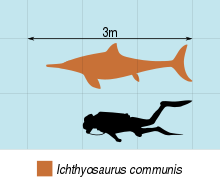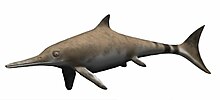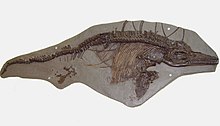Ichthyosaurus
| Ichthyosaurus | |
|---|---|

| |
| Fossil specimen ofI. somersetensisatNatural History Museum, London(NHMUK PV OR 2013) | |
| Scientific classification | |
| Domain: | Eukaryota |
| Kingdom: | Animalia |
| Phylum: | Chordata |
| Class: | Reptilia |
| Order: | †Ichthyosauria |
| Family: | †Ichthyosauridae |
| Genus: | †Ichthyosaurus De la Beche&Conybeare,1821 |
| Type species | |
| †Ichthyosaurus communis De la Beche & Conybeare, 1822
| |
| Other species | |
Ichthyosaurus(derived fromGreekἰχθύς(ichthys) meaning 'fish' andσαῦρος(sauros) meaning 'lizard') is agenusofichthyosaursfrom theEarly Jurassic(Hettangian-Pliensbachian[3]) ofEurope(Belgium,England,GermanyandPortugal[4]). Some specimens of theichthyosauridProtoichthyosaurusfromEnglandandSwitzerlandhave been erroneously referred to this genus in the past.[5][6]It is among the best known ichthyosaur genera, as it is thetype genusof theorderIchthyosauria.[7][8]
History of discovery
[edit]
Ichthyosauruswas the first complete fossil to be discovered in the early 19th century byMary AnninginEngland;[9]the holotype ofI. communis,no coll. number given,[10]was a fairly complete specimen discovered by Mary and Joseph Anning around 1814 inLyme Regis[11]but was reported as lost by McGowan (1974) in his review of the latipinnateichthyosaursofEngland.[12]The nameIchthyosauruswas first used byCharles Königin 1818, but it was not used in a formal scientific description, with the earliest described ichthyosaur beingProteosaurusby James Everard Home in 1819 for a skeleton which is now attributed toTemnodontosaurus platyodon.Henry De la BecheandWilliam Conybearein 1821 consideredIchthyosaurusto havetaxonomic priorityoverProteosaurusand named the speciesI. communisbased on BMNH 2149 (now NHMUK PV R1158), a now partially lost specimen now assigned toTemnodontosaurusthat was discovered and collected between 1811 and 1812.[13][14]One specimen that Home had assigned toProteosauruswas the first complete ichthyosaur skeleton known, but it was destroyed in WW2. Two casts were rediscovered in 2022, showing that the specimen belonged toIchthyosaurus,but of uncertain species.[15]During the 19th century, almost all fossil ichthyosaurs were attributed toIchthyosaurus,resulting in the genus having over 50 species by 1900. These species were subsequently moved to separate genera orsynonymisedwith other species.[16]
I. anningae,describedin 2015 from afossilfound in the early 1980s inDorset,England, was named after Anning.[17][18][16]The fossil was acquired byDoncaster Museum and Art Gallery,where it was misidentified as aplaster cast.In 2008, Dean Lomax, from theUniversity of Manchester,recognised it as genuine and worked with Judy Massare, of theState University of New York,to establish it as a new species.[17]
Description
[edit]
Ichthyosauruswas smaller than most of its relatives, with the largest specimen ofI. somersetensismeasuring up to 3–3.3 m (9.8–10.8 ft) in length.[19]In comparison, other species were much smaller, with theI. communisreaching up to 2 metres (6.6 ft) in length,I. larkiniprobably up to 2.5 metres (8.2 ft),I. anningaeup to 1.8 metres (5.9 ft),I. brevicepsup to 1.9 metres (6.2 ft), andI. conybeariup to 1.5 metres (4.9 ft).[1][10]ManyIchthyosaurusfossils are well-preserved and fully articulated. Some fossils still had baby specimens inside them, indicating thatIchthyosauruswasviviparous.Similar finds in the relatedStenopterygiusalso show this.[20][21]Jurassic ichthyosaurs had a fleshydorsal finon their back as well as a largecaudal fin.Icthyosaurusis distinguished from other ichthyosaurs by having a wide forefin with 5 or more digits with an anterior digital bifurcation, but the morphology of thehumerusandcoracoidsare also distinct from that of other Lower Jurassic ichthyosaurs, as is the arrangement of thedermal bones,though thesuturelines used to diagnose these are not always visible.[16]
Classification
[edit]

Thiscladogrambelow follows the topology from a 2010 analysis by Patrick S. Druckenmiller and Erin E. Maxwell.[22]
| Thunnosauria |
| ||||||||||||||||||||||||||||||||||||||||||||||||||||||||||||||||||||||||
Palaeobiology
[edit]
Ichthyosaurusis suggested to have been aram feeder,with the morphology of its hyobranchial apparatus suggesting that it was incapable ofsuction feeding,[24]using the jaws and teeth alone to capture prey.Ichthyosaurusis thought to have been a pursuit predator that was capable of sustained swift swimming viathunniform locomotion.[25]Stomach contents ofIchthyosaurus anningaeindicate that it fed oncephalopods(likelybelemnites) and fish.[26]Like other ichthyosaurs, it likely relied on its sense of sight, possibly in combination witholfaction.[27]
It was initially believed thatIchthyosauruslaid eggs on land, but fossil evidence shows that in fact the females gave birth to live young. As such, they were well-adapted to life as fully pelagic organisms (i.e. they never came onto land). The babies were born tail first to prevent them from drowning in the water.[20]
Cultural significance
[edit]
Joseph Victor von ScheffelspoemDer Ichthyosaurusdescribes its extinction in humouristic verses. A monument onHohentwielcites it as well.[28]The poem has been translated among others byCharles Godfrey Leland[29] Some of the stanzas:
The rushes are strangely rustling,
The ocean uncannily gleams,
As with tears in his eyes down gushing,
An Ichthyosaurus swims.
He bewails the frightful corruption
Of his age, for an awful tone
Has lately been noticed by many
In theLiasformation shown.
See also
[edit]References
[edit]- ^abLomax, D.R. (2019)."A revision of Ichthyosaurus (Reptilia, Ichthyosauria)"(PDF).The University of Manchester: Manchester eScholar. pp. 1–414.S2CID210305170.
- ^abDean R. Lomax; Judy A. Massare (2017). "Two new species ofIchthyosaurusfrom the lowermost Jurassic (Hettangian) of Somerset, England ".Papers in Palaeontology.3(1): 1–20.Bibcode:2017PPal....3....1L.doi:10.1002/spp2.1065.S2CID89567182.
- ^Dean R. Lomax(2010). "AnIchthyosaurus(Reptilia, Ichthyosauria) with gastric contents from Charmouth, England: First report of the genus from the Pliensbachian ".Paludicola.8(1): 22–36.
- ^Sousa, João; Mateus, Octávio (9 September 2021)."The southernmost occurrence of Ichthyosaurus from the Sinemurian of Portugal".Fossil Record.24(2): 287–294.Bibcode:2021FossR..24..287S.doi:10.5194/fr-24-287-2021.hdl:10362/131844.ISSN2193-0066.S2CID239059696.
- ^Lomax, D. R.; Porro, L. B.; Larkin, N. R. (2019)."Descriptive anatomy of the largest known specimen ofProtoichthyosaurus prostaxalis(Reptilia: Ichthyosauria) including computed tomography and digital reconstruction of a three-dimensional skull ".PeerJ.7(e6112): e6112.doi:10.7717/peerj.6112.PMC6329338.PMID30643690.
- ^Klug, C.; Sivgin, T.; Miedema, F.; Scheffold, B.; Reisdorf, A.G.; Stössel, I.; Maxwell, E.E.; Scheyer, T.M. (2024)."Swiss ichthyosaurs: a review".Swiss Journal of Palaeontology.143.31.doi:10.1186/s13358-024-00327-4.PMC11366730.
- ^Maisch MW, Matzke AT. 2000. The Ichthyosauria.Stuttgarter Beiträge zur Naturkunde, Serie B (Geologie und Paläontologie)298:1-159
- ^McGowan C, Motani R. 2003. Ichthyopterygia. – In: Sues, H.-D. (ed.):Handbook of Paleoherpetology, Part 8, Verlag Dr. Friedrich Pfeil,175 pp., 101 figs., 19 plts; München
- ^Essesials of Anthropology 6th addition
- ^abJudy A. Massare &Dean R. Lomax(2018). A taxonomic reassessment ofIchthyosaurus communisandI. intermediusand a revised diagnosis for the genus,Journal of Systematic Palaeontology,16:3, 263-277, DOI: 10.1080/14772019.2017.129111
- ^Home, E.(1814). Some account of the fossil remains of an animal more nearly allied to fishes than any other classes of animals.Philosophical Transactions of the Royal Society of London,101, 571–577.
- ^McGowan, C. (1974). A revision of the latipinnate ichthyosaurs of the Lower Jurassic of England (Reptilia: Ichthyosauria).Life Science Contributions of the Royal Ontario Museum100:1–30
- ^De la Beche, H. T. & W. D. Conybeare. (1821). Notice of the discovery of a new fossil animal, forming a link between theIchthyosaurusand crocodile, together with general remarks on the osteology of theIchthyosaurus.Transactions of the Geological Society of London5: 559–594.
- ^Conybeare, W. D.(1822). Additional notices on the fossil generaIchthyosaurusandPlesiosaurus.Transactions of the Geological Society of London,1, 103–123.
- ^Lomax, Dean R.; Massare, Judy A. (2022)."Rediscovery of two casts of the historically important ' Proteo-saurus ', the first complete ichthyosaur skeleton".Royal Society Open Science.9(11).Bibcode:2022RSOS....920966L.doi:10.1098/rsos.220966.PMC9626254.PMID36405641.
- ^abcLomax, Dean R.; Massare, Judy A. (2015)."A new species of Ichthyosaurusfrom the Lower Jurassic of West Dorset, England, U.K."Journal of Vertebrate Paleontology.35(2): e903260.Bibcode:2015JVPal..35E3260L.doi:10.1080/02724634.2014.903260.ISSN0272-4634.S2CID85745787.
- ^abGill, Victoria (19 February 2015)."BBC News - Forgotten fossil found to be new species of ichthyosaur".BBC Online.Retrieved22 February2015.
- ^"New species discovered in Doncaster".19 February 2015. Archived fromthe originalon 22 February 2015.Retrieved22 February2015.
- ^Lomax, D.R.; Sachs, S. (2017)."On the largestIchthyosaurus:A new specimen ofIchthyosaurus somersetensiscontaining an embryo ".Acta Palaeontologica Polonica.62.doi:10.4202/app.00376.2017.
- ^abBöttcher R. 1990. Neue Erkenntnisse über die Fortpflanzungsbiologie der Ichthyosaurier.Stuttgarter Beiträge zur Naturkunde, Serie B (Geologie und Paläontologie)164:1-51
- ^Martill D.M. 1993. Soupy Substrates: A Medium for the Exceptional Preservation of Ichthyosaurs of the Posidonia Shale (Lower Jurassic) of Germany.Kaupia - Darmstädter Beiträge zur Naturgeschichte2:77-97
- ^Druckenmiller, P. M.; Maxwell, E. E. (2010). "A new Lower Cretaceous (lower Albian) ichthyosaur genus from the Clearwater Formation, Alberta, Canada".Canadian Journal of Earth Sciences.47(8): 1037–1053.Bibcode:2010CaJES..47.1037D.doi:10.1139/E10-028.
- ^abArkhangel’sky, M. S., 1998, On the Ichthyosaurian Genus Platypterygius: Palaeontological Journal, v. 32, n. 6, p. 611-615.
- ^Motani, Ryosuke; Ji, Cheng; Tomita, Taketeru; Kelley, Neil; Maxwell, Erin; Jiang, Da-yong; Sander, Paul Martin (11 December 2013). Dodson, Peter (ed.)."Absence of Suction Feeding Ichthyosaurs and Its Implications for Triassic Mesopelagic Paleoecology".PLOS ONE.8(12): e66075.Bibcode:2013PLoSO...866075M.doi:10.1371/journal.pone.0066075.ISSN1932-6203.PMC3859474.PMID24348983.
- ^Dick, Daniel G.; Maxwell, Erin E. (July 2015)."The evolution and extinction of the ichthyosaurs from the perspective of quantitative ecospace modelling".Biology Letters.11(7): 20150339.doi:10.1098/rsbl.2015.0339.ISSN1744-9561.PMC4528449.PMID26156130.
- ^D.R. LomaxAnIchthyosaurus(Reptilia: Ichthyosauria) with gastric contents from Charmouth, England: first report of the genus from the PliensbachianPaludicola, 8 (2010), pp. 23-36
- ^Müller, Johannes; Bickelmann, Constanze; Sobral, Gabriela (30 May 2018)."The Evolution and Fossil History of Sensory Perception in Amniote Vertebrates".Annual Review of Earth and Planetary Sciences.46(1): 495–519.Bibcode:2018AREPS..46..495M.doi:10.1146/annurev-earth-082517-010120.ISSN0084-6597.
- ^Werkkatalog Sieckes(PDF; 7,7 MB)
- ^Charles Godfrey Leland,Gaudeamus! Humorous Poems by Joseph Viktor von Scheffel,Ebook-Nr. 35848 on gutenberg.org
- Ichthyosaurs of Europe
- Early Jurassic ichthyosaurs
- Early Jurassic reptiles of Europe
- Late Triassic ichthyosaurs
- Late Triassic reptiles of Europe
- Fossil taxa described in 1821
- Rhaetian first appearances
- Taxa named by Henry De la Beche
- Taxa named by William Conybeare
- Early Jurassic extinctions
- Ichthyosauromorph genera








